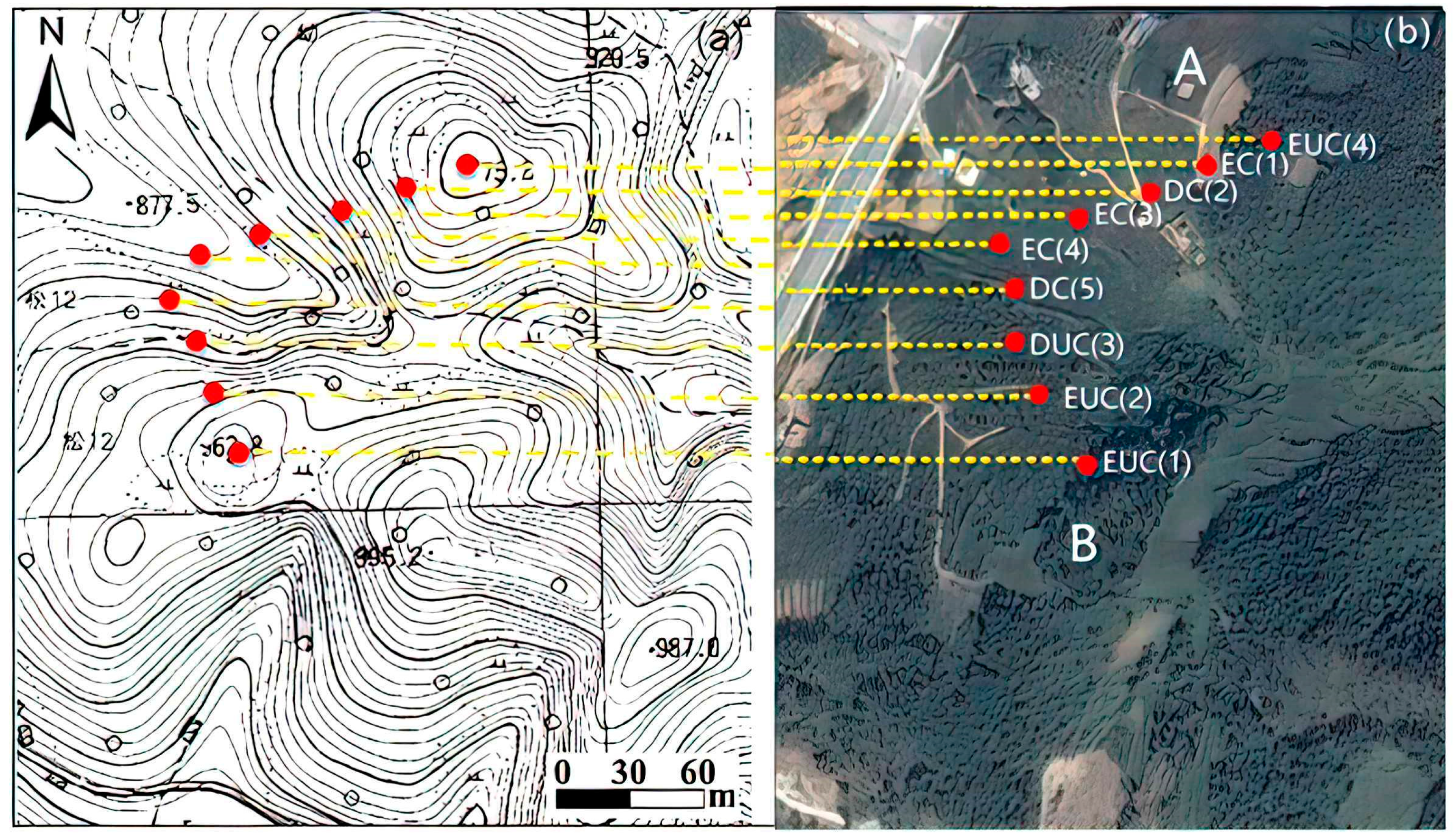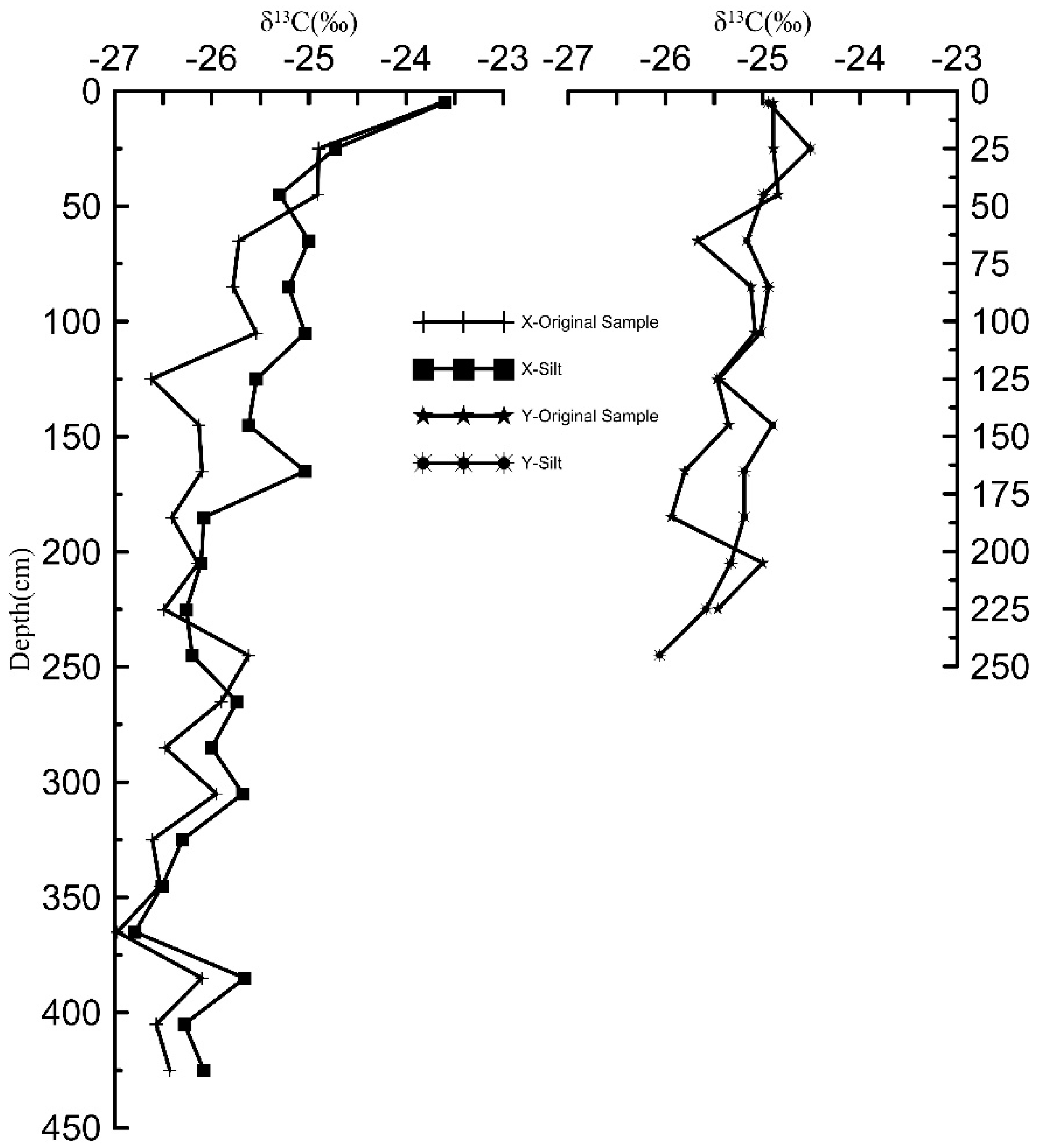The Combined Use of 137Cs Measurements and Zr-Methods for Estimating Soil Erosion and Weathering in Karst Areas of Southwestern China
Abstract
:1. Introduction
2. Materials and Methods
2.1. Study Area
2.2. Field Soil Sampling and Laboratory Analysis
2.3. Physical Erosion Rate
2.4. Chemical Erosion Rate of the Profile
3. Results and Discussion
3.1. Evaluation of Physical Erosion
3.2. Distribution Characteristics of Zr
3.3. Evaluation of Chemical Erosion
4. Conclusions
Author Contributions
Funding
Institutional Review Board Statement
Informed Consent Statement
Data Availability Statement
Conflicts of Interest
References
- Riebe, C.S.; Kirchner, J.W.; Finkel, R.C. Long-term rates of chemical weathering and physical erosion from cosmogenic nuclides and geochemical mass balance. Geochim. Cosmochim. Acta 2003, 67, 4411–4427. [Google Scholar] [CrossRef]
- Brantley, S.L.; Goldhaber, M.B.; Ragnarsdottir, K.V. Crossing Disciplines and Scales to Understand the Critical Zone. Elements 2007, 3, 307–314. [Google Scholar] [CrossRef]
- Braun, J.; Ngoupayou, J.R.N.; Viers, J.; Dupre, B.; Bedimo Bedimo, J.; Boeglin, J.; Robain, H.; Nyeck, B.; Freydier, R.; Nkamdjou, L.S.; et al. Present weathering rates in a humid tropical watershed: Nsimi, South Cameroon. Geochim. Cosmochim. Acta 2005, 69, 357–387. [Google Scholar] [CrossRef]
- Yuan, D. Carbon cycle in earth system and its effects on environment and resources. Quat. Sci. 2001, 21, 223–232. [Google Scholar]
- Mabit, L.; Chhem-Kieth, S.; Dornhofer, P.; Toloza, A.; Benmansour, M.; Bernard, C.; Fulajtar, E.; Walling, D.E. 137Cs: A Widely Used and Validated Medium-Term Soil Tracer; IAEA publication: Vienna, Austria, 2014; pp. 27–77. [Google Scholar]
- Bai, X. Assessment of sediment and erosion rates by using the caesium-137 technique in a Chinese polygonal karst depression. Environ. Earth Sci. 2011, 64, 2151–2158. [Google Scholar] [CrossRef]
- Bai, X.; Zhang, X.; Chen, H.; He, Y. Using137Cs fingerprint technique to estimate sediment deposition and erosion rates from Yongkang depression in karst region of Southwest China. Land. Degrad. Dev. 2010, 21, 474–479. [Google Scholar] [CrossRef]
- Feng, T.; Chen, H.; Zhang, W.; Nie, Y.; Wang, K. Cs-137 profile distribution character and its implication for soil erosion on Karst slopes of Northwest Guangxi. Yingyong Shengtai Xuebao 2011, 22, 593–599. [Google Scholar]
- Zhang, X.; Wang, K.; Zhang, W.; Chen, H.; He, X.; Zhang, X. Distribution of 137Cs and relative influencing factors on typical karst sloping land. Environ. Sci. 2009, 30, 3152–3158. [Google Scholar]
- Yin, C.; Ji, H. A (137)Cs Erosion Model with Moving Boundary. J. Environ. Radioactiv. 2015, 150, 152–158. [Google Scholar] [CrossRef]
- Song, C.; Ji, H.; Howard, B.; Chu, H.; Zhang, K.; Wang, S. Assessment of chemical weathering and physical erosion along a hillslope, southwest China. Catena 2019, 182, 104133. [Google Scholar] [CrossRef]
- Song, C.; Ji, H.; Howard, B.; Chang, C.; Wang, S. Features of soil redistribution and major element migration in a karst hillslope of Southwest China. J. Mt. Sci. 2018, 15, 1892–1908. [Google Scholar] [CrossRef]
- Yuan, D.; Cai, G. Karst Environment; Chongqing Publishing House: Chongqing, China, 1988. [Google Scholar]
- Yang, R.; Zhu, L.; Wei, H.; Wang, W.; Bao, M.; Zhang, X.; Liu, L. Pedogenic Mechanism of Carbonate Laterite and Its Characteristics in Guiyang, Guizhou Province, China. Earth Environ. 2007, 25, 193–201. [Google Scholar]
- Yuan, D. Karst in Southwest China and Its Comparison with Karst in North China. Quat. Sci. 1992, 4, 352–361. [Google Scholar]
- Anderson, S.P.; Dietrich, W.E.; Brimhall, G.H. Weathering profiles, mass-balance analysis, and rates of solute loss: Linkages between weathering and erosion in a small, steep catchment. GSA Bull. 2002, 9, 1143–1158. [Google Scholar] [CrossRef]
- Brimhall, G.H.; Chadwick, O.A.; Lewis, C.J.; Compston, W.; Williams, I.S.; Danti, K.J.; Dietrich, W.E.; Power, M.E.; Hendricks, D.; Bratt, J. Deformational mass transport and invasive processes in soil evolution. Science 1992, 255, 695–702. [Google Scholar] [CrossRef]
- Ferrier, K.L.; Kirchner, J.W.; Riebe, C.S.; Finkel, R.C. Mineral-specific chemical weathering rates over millennial timescales: Measurements at Rio Icacos, Puerto Rico. Chem. Geol. 2010, 277, 101–114. [Google Scholar] [CrossRef]
- Kirchner, J.W.; Riebe, C.S.; Ferrier, K.L.; Finkel, R.C. Cosmogenic nuclide methods for measuring long-term rates of physical erosion and chemical weathering. J. Geochem. Explor. 2006, 88, 296–299. [Google Scholar] [CrossRef]
- Lebedeva, M.I.; Fletcher, R.C.; Brantley, S.L. A mathematical model for steady-state regolith production at constant erosion rate. Earth Surf. Proc. Land 2010, 35, 508–524. [Google Scholar] [CrossRef]
- West, A.J.; Galy, A.; Bickle, M. Tectonic and climatic controls on silicate weathering. Earth Planet. Sc. Lett. 2005, 235, 211–228. [Google Scholar] [CrossRef]
- Yoo, K.; Amundson, R.; Heimsath, A.M.; Dietrich, W.E.; Brimhall, G.H. Integration of geochemical mass balance with sediment transport to calculate rates of soil chemical weathering and transport on hillslopes. J. Geophys. Res. 2007, 112, F02013. [Google Scholar] [CrossRef] [Green Version]
- Riebe, C.S. Erosional and climatic effects on long-term chemical weathering rates in granitic landscapes spanning diverse climate regimes. Earth Planet. Sci. Lett. 2004, 224, 547–562. [Google Scholar] [CrossRef]
- Riebe, C.S.; Kirchner, J.W.; Finkel, R.C. Sharp decrease in long-term chemical weathering rates along an altitudinal transect. Earth Planet Sci. Lett. 2004, 218, 421–434. [Google Scholar] [CrossRef]
- Zhao, Y.; Han, R.; Cui, N.; Yang, J.; Guo, L. The Impact of Urbanization on Ecosystem Health in Typical Karst Areas: A Case Study of Liupanshui City, China. Int. J. Environ. Res. Public Health 2020, 18, 93. [Google Scholar] [CrossRef] [PubMed]
- Bai, Z.; Wan, G. Study on watershed erosion rate and Its environmental effects in Guizhou karst region. J. Soil Eros. Soil Water Conserv. 1998, 4, 2–8. [Google Scholar]
- Yin, C. Weathering Erosion and Element Migration in the Critical Zone of Karst, Zunyi, Guizhou; China Water Conservancy Press: Beijing, China, 2019. [Google Scholar]
- Liu, C. Biogeochemical Processes and Surface Material Cycling in the Southwest Karst Basin and the Cycle of Biogenic Elements; Science Press: Beijing, China, 2007. [Google Scholar]
- Jiang, Z. Element migration of karst dynamic system. Acta Geogr. Sin. 1999, 54, 438–444. [Google Scholar]
- Liu, Y.; Lv, Y.; Fu, B.; Liu, G. Reference value of137Cs tracing technique in soil loss estimation: A spatial variation analysis. Geogr. Res. 2010, 29, 1171–1181. [Google Scholar]
- Yan, D.; Wen, A.; Bao, Y.; Zhang, X. The distribution of 137Cs in hilly upland soil on the Qianzhong Karst Plateau. Earth Environ. 2008, 36, 342–347. [Google Scholar]
- Bai, X.; Zhang, X.; Wang, S.; Yan, D.; Li, H. Estimating Sediment Deposition Rates by the Cs- 137 Technique in Karst Depression of Chongtou, Puding County, Guizhou Province. Earth Environ. 2009, 37, 142–146. [Google Scholar]
- Loughran, R.C.; Campbell, B.L. The identification of catchment sediment sources. In Sediment and Water Quality in River Cathments; Foster, I.D.L., Gurnell, A.M., Webb, B.W., Eds.; Wiley: Chichester, UK, 1995; pp. 189–205. [Google Scholar]
- Zhang, X.; Higgitt, D.L.; Walling, D.E. A preliminary assessment of the potential for use caesium-137 to estimate rates of soil erosion in the Loess Plateau of China. Hydrolog. Sci. J. 1990, 3, 243–252. [Google Scholar]
- Walling, D.E.; He, Q. Improved models for estimating soil erosion rates from cesium-137 measurements. J. Environ. Qual. 1999, 28, 611. [Google Scholar] [CrossRef]
- Zhang, X.; Long, Y.; He, X.; Fu, J.; Zhang, Y. A simplified 137Cs transport model for estimating erosion rates in undisturbed soil. J. Environ. Radioact. 2008, 99, 1242–1246. [Google Scholar] [CrossRef] [PubMed]
- Kirkwood, D.E.; Nesbitt, H.W. Formation and evolution of soils from an acidified watershed: Plastic Lake, Ontario, Canada. Geochim. Cosmochim. Acta 1991, 55, 1295–1308. [Google Scholar] [CrossRef]
- Whitfield, C.J.; Watmough, A.; Aherne, J. Evaluation of elemental depletion weathering rate esti-mation methods on acid-sensitive soils of north-eastern Alberta, Canada. Geoderma 2011, 166, 189–197. [Google Scholar] [CrossRef]
- Sun, J.; Wang, S.; Zhou, D.; Liu, X.; Ji, H. Insoluble residues of carbonate rocks as source manterial for red weathering crusts in Karst regions of GuiZhou Province, China. Acta Mineral. Sin. 2002, 22, 235–242. [Google Scholar]
- Ji, H.; OuYang, Z.; Wang, S.; Zhou, D. Element geochemical characteristics of weathered section of dolomite and its significance for the average chemical composition of the upper crust. Sci. China Ser. D 1999, 48, 504–513. [Google Scholar]
- Ouimet, R. Using compositional change within soil profiles for modelling base cation transport and chemical weathering. Geoderma 2008, 145, 410–418. [Google Scholar] [CrossRef]
- Gao, J.; Li, R.; Lin, J.; Zhang, L.; Ji, H. Grain size distribution, element migration, and stable carbon isotope characteristics of dolomite weathering profiles in Xinpu, North of Guizhou Province. Acta Ecol. Sin. 2016, 36, 12–18. [Google Scholar]
- Zhang, W.; Liao, H.; Long, J.; Li, J.; Liu, L. Effects of land use on soil organic carbon and its turnover rate in Karst mountain areas of Guizhou Province. Chin. J. Ecol. 2014, 33, 1297–1303. [Google Scholar]
- Zhu, Y.; Yang, J.; Chen, J.; Liu, X.; Xu, X.; Sun, Z. Effect of fertilizer application and deep rooting measures on the absorption of 137Cs by rice. Acta Agric. Nucleatae Sin. 1998, 12, 38–43. [Google Scholar]
- Li, D. Contemporary Yugong moves mountains again – a documentary on the transformation of cultivated land by militia in Zunyi area. Southwest militia. 1995, 5, 16. [Google Scholar]
- Tang, K. Soil and Water Conservation in China; Science Press: Beijing, China, 2004. [Google Scholar]
- Jiao, S.L.; Liang, H. Chemical Weathering Processes and Its Atmospherical CO2 Consumption of the Bainihe Watershed in Wujiang River Source Drainage Basins Area. Sci. Technol. Rev. 2012, 30, 89–93. [Google Scholar]
- Yoo, K.; Mudd, S.M.; Sanderman, J.; Amundson, R.; Blum, A. Spatial patterns and controls of soil chemical weathering rates along a transient hillslope. Earth Planet. Sci. Lett. 2009, 288, 184–193. [Google Scholar] [CrossRef]






| Sample Site | 137Cs Inventory (Bq/m2) | Erosion Rate (t/(km2·a)) | Deposition Rate (t/(km2·a)) |
|---|---|---|---|
| EUC(1) | 150 | 1911 | - |
| EUC(2) | 846 | 130 | - |
| DUC(3) | 1626 | - | 520 |
| DC(5) | 1002 | - | 39 |
| EC(4) | 384 | 949 | - |
| EUC(4) | 759 | 234 | - |
| EC(1) | 951 | 9 | - |
| DC(2) | 1411 | - | 390 |
| EC(3) | 749 | 247 | - |
| Sample Site | Dividing Depth (cm) | h1 Average Concentration of Zr (mg/kg) | h2 Average Concentration of Zr (mg/kg) | Physical Erosion Rate (t/(km2·a)) | Chemical Weathering Rate (t/(km2·a)) |
|---|---|---|---|---|---|
| EUC(1) | 20 | 145 | 141 | 1911 | 53.8 |
| EUC(2) | 20 | 266 | 250 | 130 | 8.3 |
| DUC(3) | 12 | 286 | 273 | −520 | 24.7 |
Publisher’s Note: MDPI stays neutral with regard to jurisdictional claims in published maps and institutional affiliations. |
© 2022 by the authors. Licensee MDPI, Basel, Switzerland. This article is an open access article distributed under the terms and conditions of the Creative Commons Attribution (CC BY) license (https://creativecommons.org/licenses/by/4.0/).
Share and Cite
Yin, C.; Li, J.; Ji, H.; Song, C.; Du, M. The Combined Use of 137Cs Measurements and Zr-Methods for Estimating Soil Erosion and Weathering in Karst Areas of Southwestern China. Sustainability 2022, 14, 4810. https://doi.org/10.3390/su14084810
Yin C, Li J, Ji H, Song C, Du M. The Combined Use of 137Cs Measurements and Zr-Methods for Estimating Soil Erosion and Weathering in Karst Areas of Southwestern China. Sustainability. 2022; 14(8):4810. https://doi.org/10.3390/su14084810
Chicago/Turabian StyleYin, Chuan, Jinjin Li, Hongbing Ji, Changshun Song, and Mingyi Du. 2022. "The Combined Use of 137Cs Measurements and Zr-Methods for Estimating Soil Erosion and Weathering in Karst Areas of Southwestern China" Sustainability 14, no. 8: 4810. https://doi.org/10.3390/su14084810






